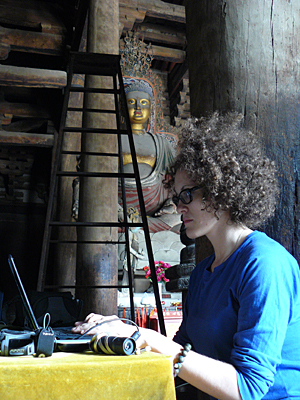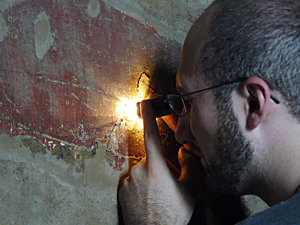

ADVERTISEMENT
- UD grad students help preserve cultural heritage across U.S., around globe
- LeeAnn Barnes Gordon: Agora Excavations, Athens, Greece
- Lauren Bradley: Walters Art Museum, Baltimore
- Alisha Chipman: Paul Messier, LLC
- Rose Daly: Nasher Sculpture Center, Dallas
- Emily MacDonald-Korth and Carlos Moya: Fengguo Temple, Yixian, China
- Amanda Maloney: C.C. von Waldthausen Fotorestauratie Atelier, Amsterdam
- Gwen Manthey: Western Center for the Conservation of Fine Arts, Denver
- Carrie Roberts: English Heritage, London
- Kirsten Travers: Stichting Restauratie Atelier Limburg, the Netherlands
- Renee Wolcott: Smithsonian National Portrait Gallery
- Erin A. Anderson: Poggio Colla, Mugello Valley of Tuscany
- Tatiana Cole: Metropolitan Museum of Art
- Anne Getts: Philadelphia Museum of Art
- Sarah Gowen and Stephanie Oman: Shangri La, Honolulu, Hawaii
- Allison Holcomb: Colonial Williamsburg, Williamsburg, Va.
- Ellen Moody: Sherman Fairchild Center, Metropolitan Museum of Art
- Steve O'Banion: Smithsonian American Art Museum, Lunder Conservation Center
- Ellen Promise: Philadelphia Museum of Art
11:23 a.m., July 28, 2010----Hidden in the small, remote town of Yixian in Liaoning Province is one of China's great cultural treasures: the Giant Buddha Temple called Fengguosi. Built between the 11th and 12th centuries during the Liao Dynasty, the temple is a uniquely ancient example of traditional Chinese wooden architecture.
In addition to the seven enormous and breathtaking wooden polychrome Buddha statues -- approximately 30 feet in height -- that dominate the temple, Fengguosi is home to a variety of other artistic treasures including beautiful examples of decorative painting on the wooden architectural elements and the incredible 12th-century murals found along the interior walls.
This past summer, we had the privilege of conducting a condition assessment of Fengguosi's wall paintings. The University of Delaware was invited to collaborate on the Fengguosi project by the prestigious Tsinghua University of Beijing, a school that is well-known for its architectural history program.
The Tsinghua team included Prof. Liu Chang and three of his graduate and doctoral students. We were headed by Susan Buck, WUDPAC professor and conservator in private practice. The UD team also included two University of Delaware art conservation undergraduates, Marlene Yandrisevits and Amanda Chau. The University of Delaware team examined the condition of the wall paintings while Tsinghua University examined the temple architecture. The collaboration involved group talks about our observations and practical demonstrations of our techniques including many aspects from both ends of the project.
During the two weeks of on-site work, the condition of the murals was studied extensively and documented using a variety of tools including ultraviolet light, portable optical microscopes, digital photography, and innovative new software tailored to art conservators called Metigo Map.
Using the Metigo software, we were able to create rectified to-scale images of sections of the mural and then use these images to digitally draw highly detailed “maps” that indicate the location and extent of the various condition issues. Metigo Map allowed for a level of specificity in the condition reporting that would not have been possible otherwise.
Additionally, the environmental conditions within the temple were monitored, a variety of cleaning tests were conducted and over 50 samples of paint and other materials were collected for further analysis at the research laboratories at the Winterthur Museum -- all in an effort to better understand the murals.
Working at Fengguosi under the giant majestic Buddhas was a surreal and enchanting experience that none of us will ever forget. Additionally, overcoming the organizational challenges presented by the scope of the project and the vast language barrier provided important lessons for the future.
Undoubtedly, the benefits of the new relationships we forged with our Chinese colleagues are innumerable and not yet fully realized. However, for all that we gained, we would also like to think that we were able to give something in return to the stewards of the temple and people of Yixian.
Our work highlighted the cultural value and fragility of the Fenggousi murals. The increased appreciation of the importance of preserving the murals was evident in the reactions of the temple's staff to a presentation that was given by Emily about our documentation project.
It is our hope that this initial documentation project will lead to an in-depth conservation project aimed at improving the preservation of the murals and to future collaborations with Tsinghua University.


